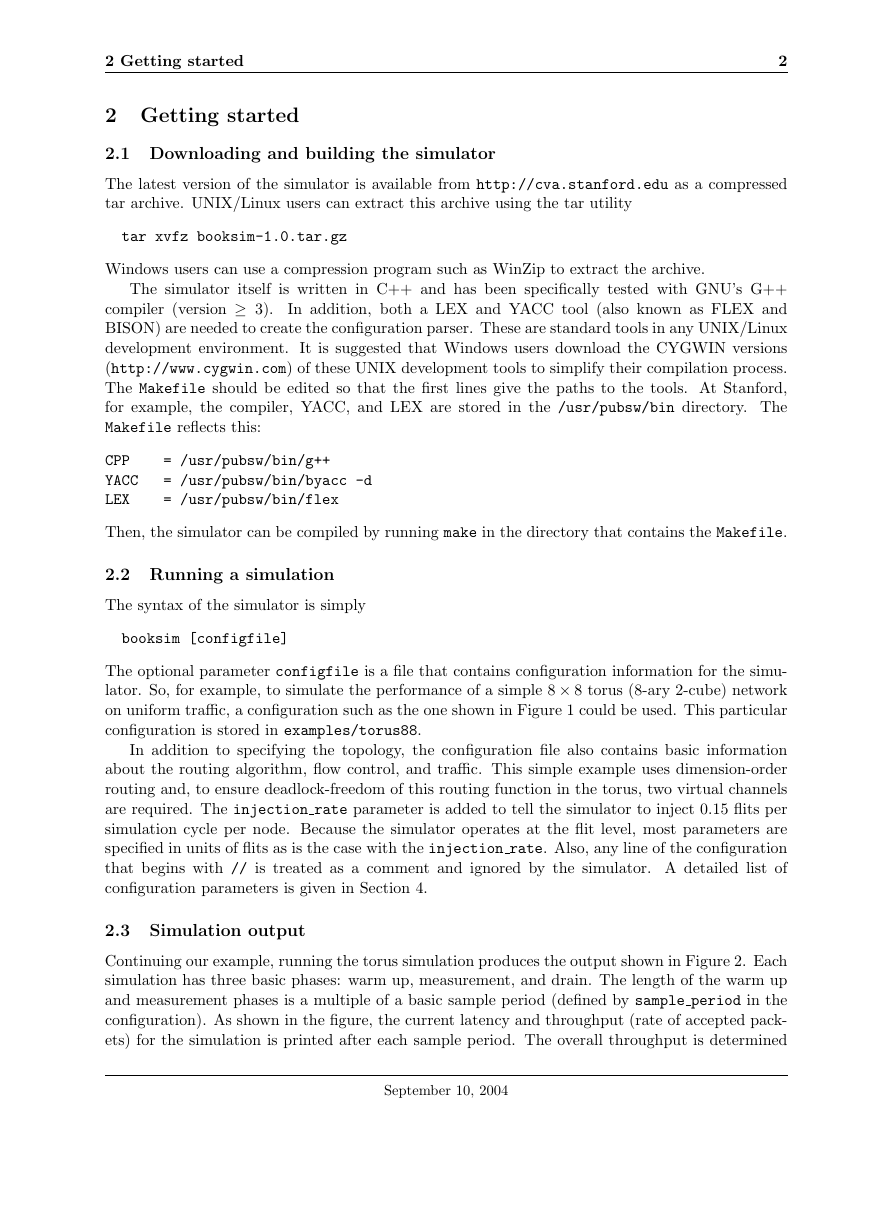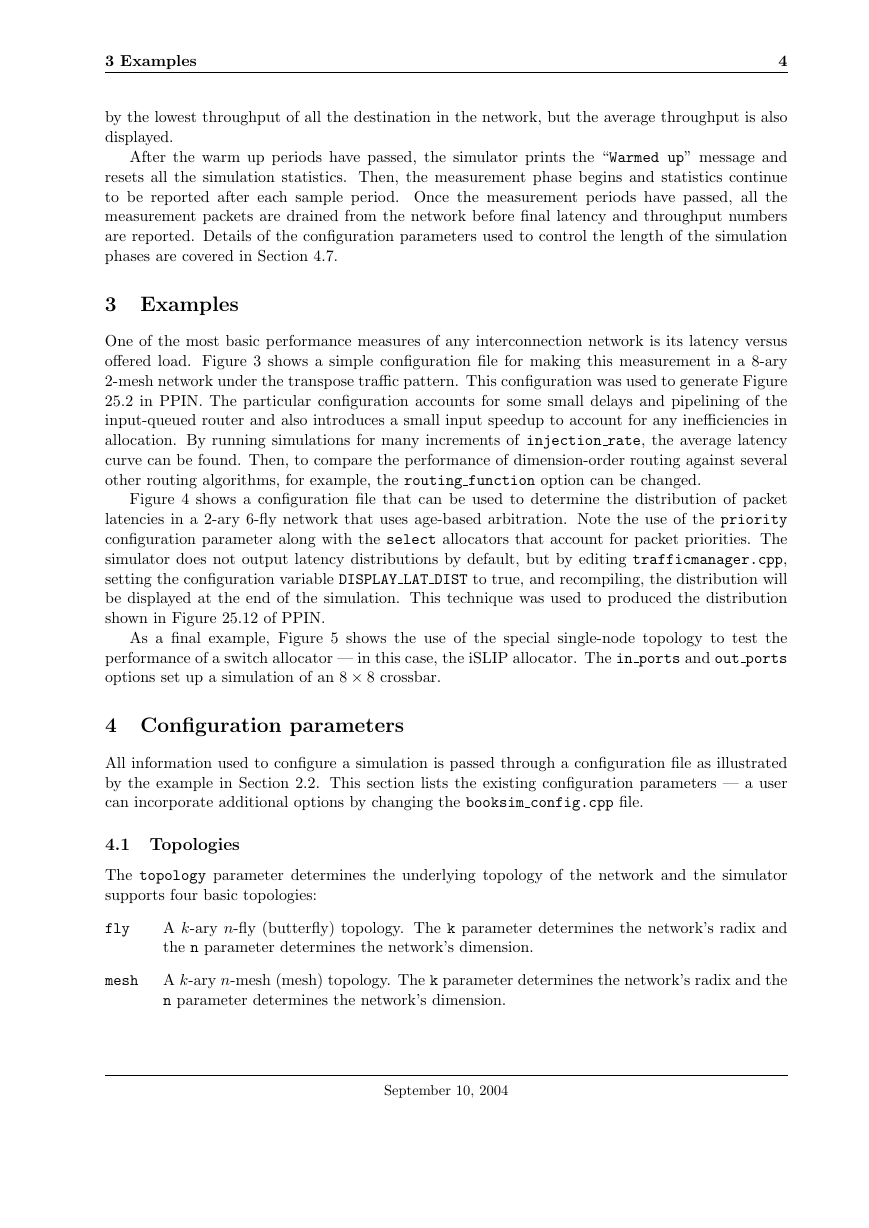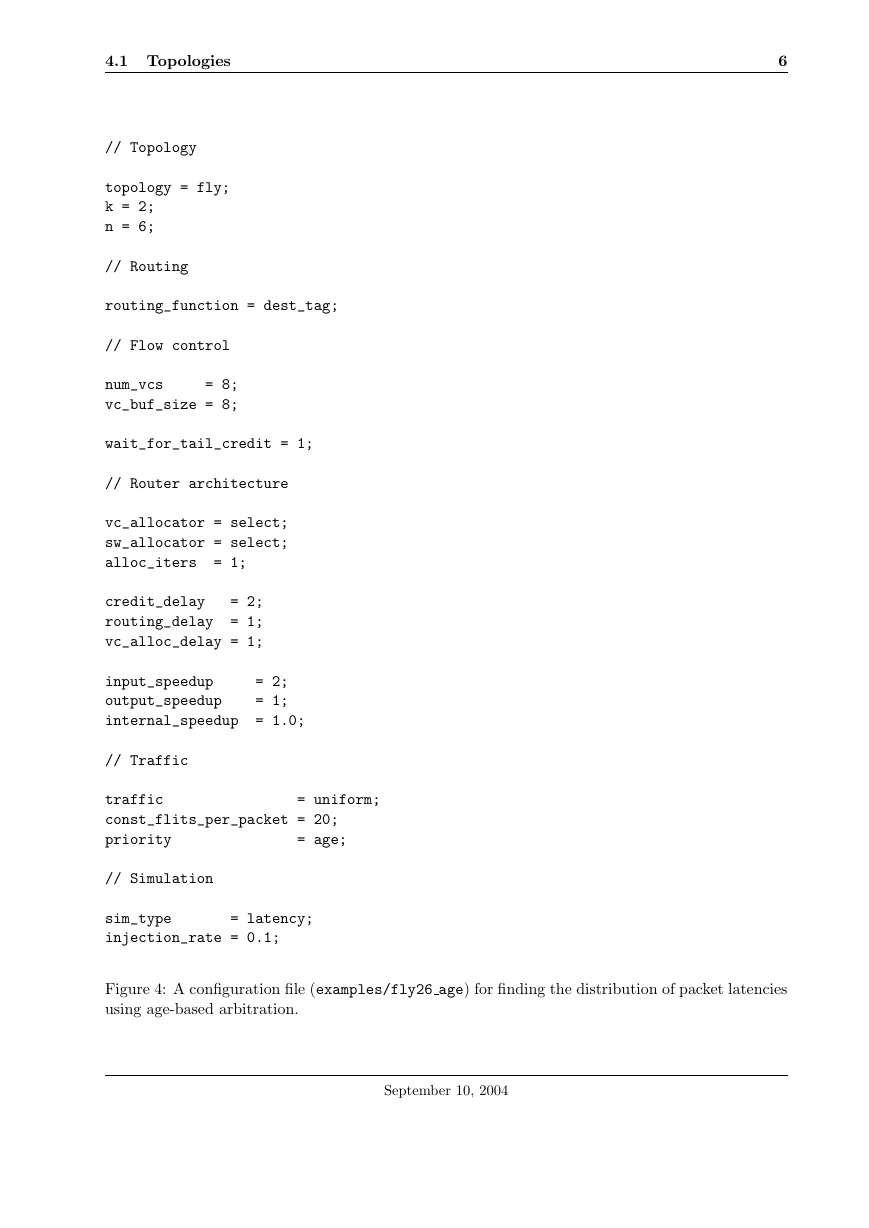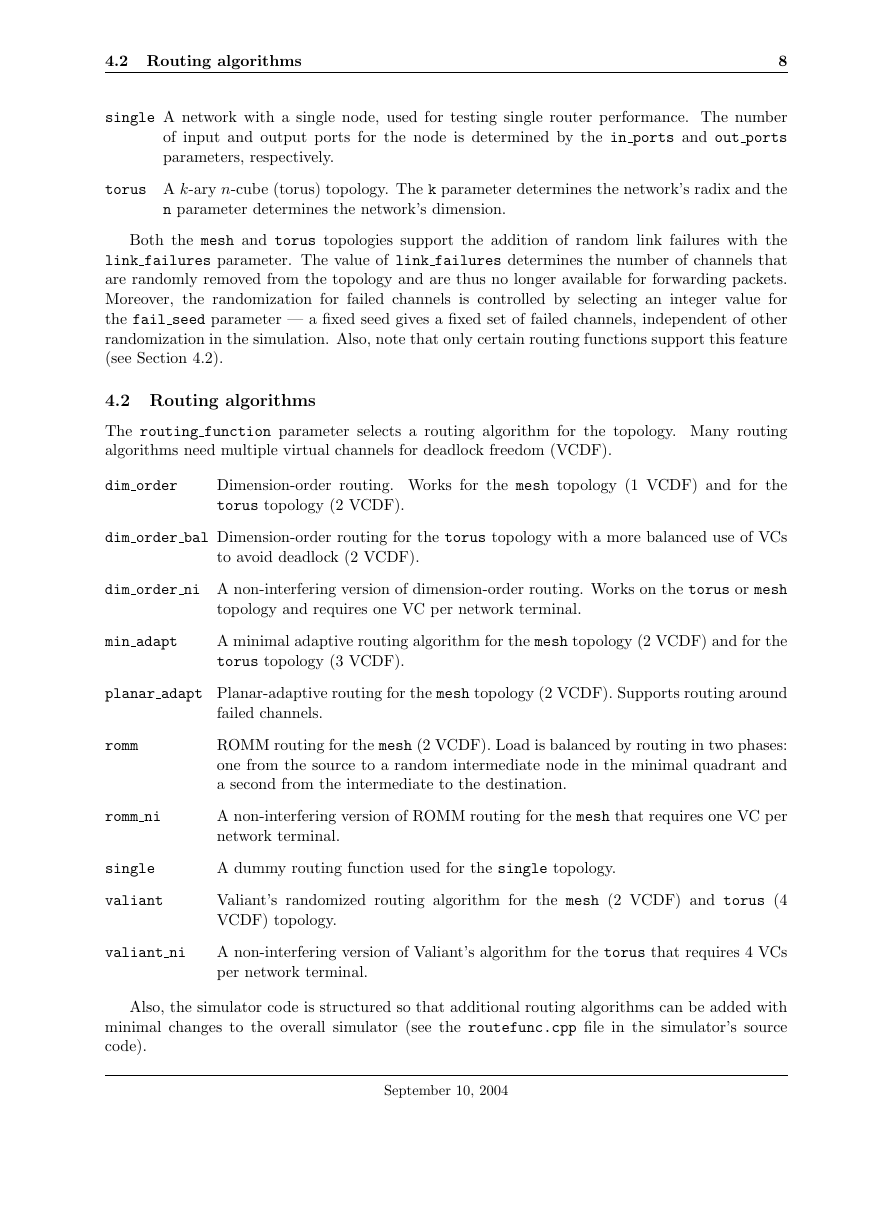BookSim 1.0 User’s Guide
Brian Towles and William J. Dally
September 10, 2004
Contents
1 Introduction
2 Getting started
2.1 Downloading and building the simulator . . . . . . . . . . . . . . . . . . . . . . . . .
2.2 Running a simulation . . . . . . . . . . . . . . . . . . . . . . . . . . . . . . . . . . .
2.3 Simulation output
. . . . . . . . . . . . . . . . . . . . . . . . . . . . . . . . . . . . .
3 Examples
1
2
2
2
2
4
4 Configuration parameters
4
4.1 Topologies . . . . . . . . . . . . . . . . . . . . . . . . . . . . . . . . . . . . . . . . . .
4
4.2 Routing algorithms . . . . . . . . . . . . . . . . . . . . . . . . . . . . . . . . . . . . .
8
4.3 Flow control . . . . . . . . . . . . . . . . . . . . . . . . . . . . . . . . . . . . . . . . .
9
4.4 Router organizations . . . . . . . . . . . . . . . . . . . . . . . . . . . . . . . . . . . .
9
4.4.1 The input-queued router . . . . . . . . . . . . . . . . . . . . . . . . . . . . . .
9
4.4.2 The event-driven router . . . . . . . . . . . . . . . . . . . . . . . . . . . . . . 10
4.5 Allocators . . . . . . . . . . . . . . . . . . . . . . . . . . . . . . . . . . . . . . . . . . 10
4.6 Traffic . . . . . . . . . . . . . . . . . . . . . . . . . . . . . . . . . . . . . . . . . . . . 10
4.7 Simulation parameters . . . . . . . . . . . . . . . . . . . . . . . . . . . . . . . . . . . 11
A Random number generation
12
1 Introduction
This document describes the use of the BookSim interconnection network simulator. The simulator
is designed as a companion to the textbook “Principles and Practices of Interconnection Networks”
(PPIN) published by Morgan Kaufmann (ISBN: 0122007514) and it is assumed that is reader is
familiar with the material covered in that text.
This user guide is fairly brief as, with most simulators, the best way to learn and understand
the simulator is to study the code. Most of the simulator’s components are designed to be modular
so tasks such as adding a new routing algorithm, topology, or router microarchitecture should not
require a complete redesign of the code. Once you have downloaded the code, compiled it, and run
a simple example (Section 2), the more detailed examples of Section 3 give a good overview of the
capabilities of the simulator. A list of configuration options is provided in Section 4 for reference.
�
2 Getting started
2 Getting started
2
2.1 Downloading and building the simulator
The latest version of the simulator is available from http://cva.stanford.edu as a compressed
tar archive. UNIX/Linux users can extract this archive using the tar utility
tar xvfz booksim-1.0.tar.gz
Windows users can use a compression program such as WinZip to extract the archive.
The simulator itself is written in C++ and has been specifically tested with GNU’s G++
compiler (version ≥ 3).
In addition, both a LEX and YACC tool (also known as FLEX and
BISON) are needed to create the configuration parser. These are standard tools in any UNIX/Linux
development environment. It is suggested that Windows users download the CYGWIN versions
(http://www.cygwin.com) of these UNIX development tools to simplify their compilation process.
The Makefile should be edited so that the first lines give the paths to the tools. At Stanford,
for example, the compiler, YACC, and LEX are stored in the /usr/pubsw/bin directory. The
Makefile reflects this:
CPP
YACC
LEX
= /usr/pubsw/bin/g++
= /usr/pubsw/bin/byacc -d
= /usr/pubsw/bin/flex
Then, the simulator can be compiled by running make in the directory that contains the Makefile.
2.2 Running a simulation
The syntax of the simulator is simply
booksim [configfile]
The optional parameter configfile is a file that contains configuration information for the simu-
lator. So, for example, to simulate the performance of a simple 8 × 8 torus (8-ary 2-cube) network
on uniform traffic, a configuration such as the one shown in Figure 1 could be used. This particular
configuration is stored in examples/torus88.
In addition to specifying the topology, the configuration file also contains basic information
about the routing algorithm, flow control, and traffic. This simple example uses dimension-order
routing and, to ensure deadlock-freedom of this routing function in the torus, two virtual channels
are required. The injection rate parameter is added to tell the simulator to inject 0.15 flits per
simulation cycle per node. Because the simulator operates at the flit level, most parameters are
specified in units of flits as is the case with the injection rate. Also, any line of the configuration
that begins with // is treated as a comment and ignored by the simulator. A detailed list of
configuration parameters is given in Section 4.
2.3 Simulation output
Continuing our example, running the torus simulation produces the output shown in Figure 2. Each
simulation has three basic phases: warm up, measurement, and drain. The length of the warm up
and measurement phases is a multiple of a basic sample period (defined by sample period in the
configuration). As shown in the figure, the current latency and throughput (rate of accepted pack-
ets) for the simulation is printed after each sample period. The overall throughput is determined
September 10, 2004
�
2.3 Simulation output
3
// Topology
topology = torus;
k
n
= 8;
= 2;
// Routing
routing_function = dim_order;
// Flow control
num_vcs = 2;
// Traffic
traffic
injection_rate = 0.15;
= uniform;
Figure 1: Example configuration file for simulating a 8-ary 2-cube network.
%=================================
% Average latency = 6.02008
% Accepted packets = 0.11 at node 52 (avg = 0.147094)
% latency change
= 1
% throughput change = 1
...
% Warmed up ...
%=================================
% Average latency = 6.0796
% Accepted packets = 0.119 at node 5 (avg = 0.148266)
= 0.00562457
% latency change
% throughput change = 0.00379387
...
% Draining all recorded packets ...
% Draining remaining packets ...
====== Traffic class 0 ======
Overall average latency = 6.09083 (1 samples)
Overall average accepted rate = 0.149475 (1 samples)
Overall min accepted rate = 0.138551 (1 samples)
Figure 2: Simulator output from running the examples/torus88 configuration file.
September 10, 2004
�
3 Examples
4
by the lowest throughput of all the destination in the network, but the average throughput is also
displayed.
After the warm up periods have passed, the simulator prints the “Warmed up” message and
resets all the simulation statistics. Then, the measurement phase begins and statistics continue
to be reported after each sample period. Once the measurement periods have passed, all the
measurement packets are drained from the network before final latency and throughput numbers
are reported. Details of the configuration parameters used to control the length of the simulation
phases are covered in Section 4.7.
3 Examples
One of the most basic performance measures of any interconnection network is its latency versus
offered load. Figure 3 shows a simple configuration file for making this measurement in a 8-ary
2-mesh network under the transpose traffic pattern. This configuration was used to generate Figure
25.2 in PPIN. The particular configuration accounts for some small delays and pipelining of the
input-queued router and also introduces a small input speedup to account for any inefficiencies in
allocation. By running simulations for many increments of injection rate, the average latency
curve can be found. Then, to compare the performance of dimension-order routing against several
other routing algorithms, for example, the routing function option can be changed.
Figure 4 shows a configuration file that can be used to determine the distribution of packet
latencies in a 2-ary 6-fly network that uses age-based arbitration. Note the use of the priority
configuration parameter along with the select allocators that account for packet priorities. The
simulator does not output latency distributions by default, but by editing trafficmanager.cpp,
setting the configuration variable DISPLAY LAT DIST to true, and recompiling, the distribution will
be displayed at the end of the simulation. This technique was used to produced the distribution
shown in Figure 25.12 of PPIN.
As a final example, Figure 5 shows the use of the special single-node topology to test the
performance of a switch allocator — in this case, the iSLIP allocator. The in ports and out ports
options set up a simulation of an 8 × 8 crossbar.
4 Configuration parameters
All information used to configure a simulation is passed through a configuration file as illustrated
by the example in Section 2.2. This section lists the existing configuration parameters — a user
can incorporate additional options by changing the booksim config.cpp file.
4.1 Topologies
The topology parameter determines the underlying topology of the network and the simulator
supports four basic topologies:
fly
mesh
A k-ary n-fly (butterfly) topology. The k parameter determines the network’s radix and
the n parameter determines the network’s dimension.
A k-ary n-mesh (mesh) topology. The k parameter determines the network’s radix and the
n parameter determines the network’s dimension.
September 10, 2004
�
4.1 Topologies
5
// Topology
topology = mesh;
k = 8;
n = 2;
// Routing
routing_function = dim_order;
// Flow control
num_vcs
= 8;
vc_buf_size = 8;
wait_for_tail_credit = 1;
// Router architecture
vc_allocator = islip;
sw_allocator = islip;
alloc_iters
= 1;
credit_delay
= 2;
routing_delay
= 1;
vc_alloc_delay = 1;
input_speedup
output_speedup
internal_speedup = 1.0;
= 2;
= 1;
// Traffic
traffic
const_flits_per_packet = 20;
= transpose;
// Simulation
sim_type
injection_rate = 0.1;
= latency;
Figure 3: A typical configuration file (examples/mesh88 lat) for creating a latency versus offered
load curve for a 8-ary 2-mesh network.
September 10, 2004
�
6
4.1 Topologies
// Topology
topology = fly;
k = 2;
n = 6;
// Routing
routing_function = dest_tag;
// Flow control
num_vcs
= 8;
vc_buf_size = 8;
wait_for_tail_credit = 1;
// Router architecture
vc_allocator = select;
sw_allocator = select;
alloc_iters
= 1;
= 2;
credit_delay
= 1;
routing_delay
vc_alloc_delay = 1;
input_speedup
output_speedup
internal_speedup = 1.0;
= 2;
= 1;
// Traffic
traffic
const_flits_per_packet = 20;
priority
= age;
= uniform;
// Simulation
sim_type
injection_rate = 0.1;
= latency;
Figure 4: A configuration file (examples/fly26 age) for finding the distribution of packet latencies
using age-based arbitration.
September 10, 2004
�
4.1 Topologies
7
// Topology
= single;
topology
in_ports
= 8;
out_ports = 8;
// Routing
routing_function = single;
// Flow control
vc_allocator = islip;
sw_allocator = islip;
alloc_iters
= 2;
num_vcs
vc_buf_size = 1000;
= 8;
wait_for_tail_credit = 0;
// Simulation
sim_type
injection_rate = 0.1;
= latency;
Figure 5: A single-node configuration file (examples/single) for testing the performance of a
switch allocator.
September 10, 2004
�
4.2 Routing algorithms
8
single A network with a single node, used for testing single router performance. The number
of input and output ports for the node is determined by the in ports and out ports
parameters, respectively.
torus A k-ary n-cube (torus) topology. The k parameter determines the network’s radix and the
n parameter determines the network’s dimension.
Both the mesh and torus topologies support the addition of random link failures with the
link failures parameter. The value of link failures determines the number of channels that
are randomly removed from the topology and are thus no longer available for forwarding packets.
Moreover, the randomization for failed channels is controlled by selecting an integer value for
the fail seed parameter — a fixed seed gives a fixed set of failed channels, independent of other
randomization in the simulation. Also, note that only certain routing functions support this feature
(see Section 4.2).
4.2 Routing algorithms
The routing function parameter selects a routing algorithm for the topology. Many routing
algorithms need multiple virtual channels for deadlock freedom (VCDF).
dim order
Dimension-order routing. Works for the mesh topology (1 VCDF) and for the
torus topology (2 VCDF).
dim order bal Dimension-order routing for the torus topology with a more balanced use of VCs
to avoid deadlock (2 VCDF).
dim order ni A non-interfering version of dimension-order routing. Works on the torus or mesh
topology and requires one VC per network terminal.
min adapt
A minimal adaptive routing algorithm for the mesh topology (2 VCDF) and for the
torus topology (3 VCDF).
planar adapt Planar-adaptive routing for the mesh topology (2 VCDF). Supports routing around
failed channels.
romm
romm ni
single
valiant
ROMM routing for the mesh (2 VCDF). Load is balanced by routing in two phases:
one from the source to a random intermediate node in the minimal quadrant and
a second from the intermediate to the destination.
A non-interfering version of ROMM routing for the mesh that requires one VC per
network terminal.
A dummy routing function used for the single topology.
Valiant’s randomized routing algorithm for the mesh (2 VCDF) and torus (4
VCDF) topology.
valiant ni
A non-interfering version of Valiant’s algorithm for the torus that requires 4 VCs
per network terminal.
Also, the simulator code is structured so that additional routing algorithms can be added with
minimal changes to the overall simulator (see the routefunc.cpp file in the simulator’s source
code).
September 10, 2004
�
















 2023年江西萍乡中考道德与法治真题及答案.doc
2023年江西萍乡中考道德与法治真题及答案.doc 2012年重庆南川中考生物真题及答案.doc
2012年重庆南川中考生物真题及答案.doc 2013年江西师范大学地理学综合及文艺理论基础考研真题.doc
2013年江西师范大学地理学综合及文艺理论基础考研真题.doc 2020年四川甘孜小升初语文真题及答案I卷.doc
2020年四川甘孜小升初语文真题及答案I卷.doc 2020年注册岩土工程师专业基础考试真题及答案.doc
2020年注册岩土工程师专业基础考试真题及答案.doc 2023-2024学年福建省厦门市九年级上学期数学月考试题及答案.doc
2023-2024学年福建省厦门市九年级上学期数学月考试题及答案.doc 2021-2022学年辽宁省沈阳市大东区九年级上学期语文期末试题及答案.doc
2021-2022学年辽宁省沈阳市大东区九年级上学期语文期末试题及答案.doc 2022-2023学年北京东城区初三第一学期物理期末试卷及答案.doc
2022-2023学年北京东城区初三第一学期物理期末试卷及答案.doc 2018上半年江西教师资格初中地理学科知识与教学能力真题及答案.doc
2018上半年江西教师资格初中地理学科知识与教学能力真题及答案.doc 2012年河北国家公务员申论考试真题及答案-省级.doc
2012年河北国家公务员申论考试真题及答案-省级.doc 2020-2021学年江苏省扬州市江都区邵樊片九年级上学期数学第一次质量检测试题及答案.doc
2020-2021学年江苏省扬州市江都区邵樊片九年级上学期数学第一次质量检测试题及答案.doc 2022下半年黑龙江教师资格证中学综合素质真题及答案.doc
2022下半年黑龙江教师资格证中学综合素质真题及答案.doc